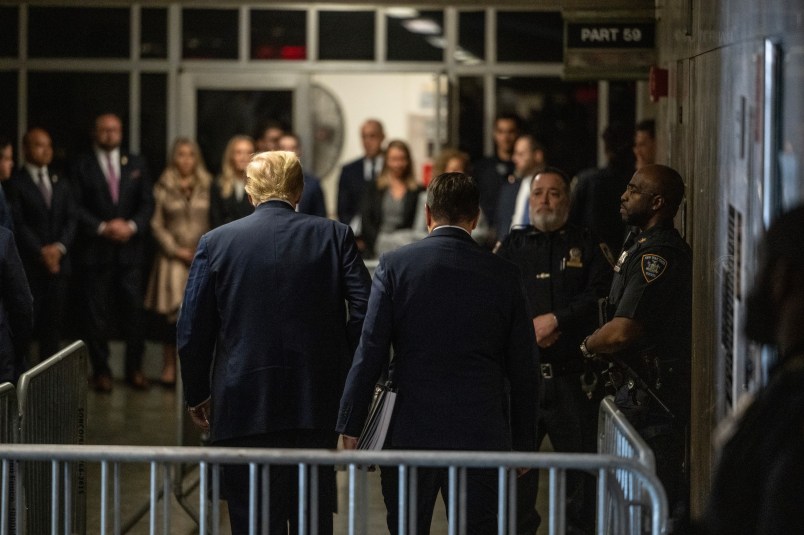I’m never sure with William Safire where the line is between Safire the snookered and Safire the snookerer. Nor am I sure which is the case in this instance. (With so many permutations of snookerhood I need a language maven to sort out all the possibilities. But I’m not sure he’d take my call.)
Safire is now the first columnist to grab hold of the story which ran in Financial Times on Monday alleging A) a new trove of evidence that Iraq and other nations were illicitly seeking to purchase uranium from Niger and B) that the mystery of who is behind the notorious Niger uranium forgeries has been solved.
The FT story is yet to have been picked up by other news outlets in the United States but it has become a matter of acute interest and frenzied promotion for what I guess we’d call certain interested parties in Washington. And I half suspect that one of them put Safire on to his piece.
In any case, to Safire …
Safire’s claim is that the CIA ignored solid intelligence — principally from the Italians, but also from the Brits and the French — and then fumbled the ball irretrievably by getting bamboozled by the phony documents.
Here’s Safire …
A close reading of the article suggests the original human source was Italian, whose tip was confirmed by British and French electronic intercepts. C.I.A. analysts, who often disdain data not gathered by us, ignored the real thing until they were suckered by the forged documents.
That’s astonishing. Is that really how it happened? Not really.
This is an object lesson in how if you’re going to run with a story based largely on disinformation from two foreign intelligence services, it’s worth cranking up the Nexis database at least to get yourself up to speed on what’s already known about the story. Otherwise, things can really get messy.
As is known, even from published sources, the Italians first sent Washington their reports about alleged sales of uranium from Niger to Iraq in late 2001. The FT article and Safire suggest that this choice information was ignored by the CIA.
Not so.
For better or worse, the American intelligence community’s assumptions about an Iraqi nuclear program — as opposed to the Bush White House’s late, pre-war propaganda campaign, which was quite a different thing — were not principally tied to the Niger uranium story. But the US government’s interest in the Niger uranium story did stem from the information received from the Italians in late 2001.
They weren’t ignored at all. Indeed, with no little pressure from Vice President Cheney, it was based on that and a subsequent report from the Italians that Joe Wilson was sent to Niger in the spring of 2002.
The essential falsehood in Safire’s tale is the claim that that supposedly choice info from the Italians had no connection to those phony documents. But that’s not true. Not true at all.
You can approach this on a different level. Safire would like us to believe the Bush White House, faced last July with a PR catastrophe over the president’s use of the Niger uranium claim in the State of the Union address, decided to fold its cards and issue a series of rather abject apologies even though they had this rock-solid intelligence that they could have used to go on the offensive. That make sense to you? Me neither.
There’s a lot of disinformation coming down the pike on this and related stories. Safire is just the peddler of the day, enabled by the fact that he’s either uninterested or indifferent to checking out the facts of the story.
There’s a body of sociological literature which shows that when the world does not come to an end on the day prescribed by this or that messianic cult, the cult usually does not fall apart. Rather, their belief only tends to intensify to still greater levels. Safire seems to be an example of the same phenomenon only applied to Iraqi WMD cult.
Now, before signing off for the evening, another point about Safire and the FT article — but this one is more speculative.
One premise of the two FT articles was that smugglers were getting uranium from derelict (and thus unguarded and unregulated) mines in Niger to sell to five countries.
Safire mentions three of the alleged countries: Iran, Iraq and Libya. The FT includes the other two: North Korea and China.
On its face, it’s not inconceivable that countries seeking nuclear weapons technology like Iran, Iraq, Libya and North Korea would be in the market for illicit supplies of processed uranium.
But China? Last time I checked China is an acknowledged nuclear power and has been for decades. They also have a growing civilian nuclear power program. Perhaps most to the point they have big uranium mines in their own country and a national monopoly company (the China National Nuclear Corporation) charged with the running the mines and the nearby-located processing facilities. The IAEA says the Chinese have the domestic capacity to process 1200 tons of uranium a year.
Now, I don’t know the precise needs of Chinese civilian and military nuclear activities. But given their own domestic capabilities, how likely is it that they’re going to try to cut a deal with low-rent smugglers to get some uranium from derelict (and thus not very productive) mines in Niger? Does that make sense?
I’d be curious to hear from non-proliferation folks on how great China’s need is for foreign imports of processed uranium and whether they’re so desperate as to resort to negotiations with smugglers who say they can get some uranium out of some abandoned mines in Niger.








